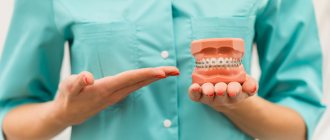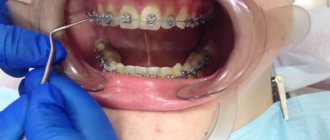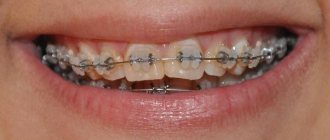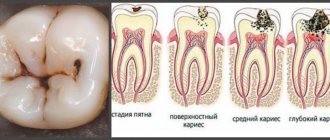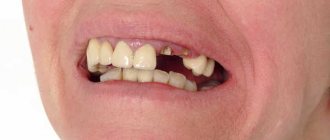People who have decided to get rid of a certain dental defect that reduces their level of comfort in life make an appointment with an orthodontist. Some suffer from a single crooked tooth that disrupts the aesthetics of their smile, while others have already encountered facial deformation caused by several unfolded, incorrectly positioned teeth.
In any case, the future patient is concerned exclusively with the issue of aesthetics, and from treatment with braces he expects only one thing - getting rid of the defect, which is often observed only in the upper or, less commonly, only in the lower jaw. Therefore, the proposal to install a device on both often causes surprise and is regarded as the doctor’s desire to earn extra money by unjustifiably increasing the amount of necessary correction (especially since the cost of turnkey braces is still quite impressive).
To figure out whether it is possible to put braces on one jaw, let's evaluate the situation from the point of view of a specialist.
Place braces on one or two jaws
Many patients flatly refuse treatment with braces if they require fastening on both jaws. Patients argue their point of view by saying that since their teeth are crooked in only one of the rows, there is no need to wear the device on both jaws. But in such cases, we should not forget about the purpose of braces. They are used both to straighten dental crooks and to eliminate bite defects.
The quality of chewing food in the mouth and, consequently, the health of the digestive canal organs directly depends on the correctness of the bite (the closure of the dental units of the upper and lower tiers). Clients of dental clinics may not know about this, especially if the malocclusion does not cause them noticeable discomfort.
How does the leveling process occur if a one-sided device is used? Over the years, the dental system is formed for a certain position of the teeth. For example, the lower healthy row adapts to the upper row, which has curvature. At one not at all wonderful moment, the patient will definitely feel that the closure process has become difficult. To avoid the development of further negative consequences, you need to:
- conducting an X-ray examination;
- checking the condition of bone tissue;
- assessment of dental roots.
After diagnosis, the doctor decides on the advisability of installing a corrective product on only one jaw. If the orthodontist recommends treatment for one dental tier, then the other will certainly be monitored. This is necessary in order to promptly apply appropriate measures to prevent possible complications. For example, to correct the lower row, retainers are used - special orthodontic products that can be removed independently. Retainers are worn at night or used during the day (several hours).
Preventive measures
Whether or not you will need to have dental work done after your braces are removed is largely up to you. With proper care, the likelihood of developing carious processes is very small. Your doctor will definitely explain the basic rules to you after installing braces. There are three main points here.
- Using additional tools for high-quality cleaning: orthodontic brushes, dental floss and irrigator. The latest device helps to efficiently remove even the smallest particles of food from the most inaccessible places. You need to brush your teeth after every meal.
- Using fluoride toothpastes and rinses. Use these products at least twice a day.
- Periodic professional teeth cleaning – about 2-3 times a year.
If these conditions are met, you will be able to maintain the health of your tooth enamel and achieve a beautiful smile at the end of treatment. Be sure to see your orthodontist regularly so that he or she can monitor the movement of your teeth and identify problems early.
Types and design of braces
As practice shows, systems are often installed on the upper jaw. This is due to the desire of patients to get a “Hollywood” smile. Since the lower teeth are less visible during communication, people are less likely to worry about their straightness.
The orthodontic market offers a wide range of corrective mechanisms for the upper teeth, made from different raw materials. You can choose expensive aesthetic braces, or you can give preference to cheap but noticeable products. The appropriate design of braces is determined by the doctor, guided by the diagnosis and personal characteristics of the patient’s oral cavity.
By design, braces are classified as follows:
- ligatures;
- self-regulating;
- internal (lingual);
- removable devices (mouth guards).
Ligature braces cause discomfort when worn and change the chewing load. A person will have to wait until the end of the adaptation period and get used to constant pressure. The patient can adjust the self-regulating systems himself, if necessary, so that the resulting unpleasant sensations are minimized. The cost of such devices will be higher than ligature products.
The most expensive are lingual braces. They are attached to the inner surface of the teeth. These devices do not cause cosmetic inconvenience, they are not noticeable to others, and also do not have a negative effect on the bite (closure). The high price of lingual braces is due to the fact that precious metals (for example, gold) are used in their manufacture. In addition to the high cost, one of the disadvantages can also be mentioned such a phenomenon as a temporary distortion of diction immediately after installing the system.
Comparison of systems up close
Removable aligners are used when correction is required for one or two dental units. The advantages of such products are reasonable cost and the ability to remove the device yourself. The disadvantage is that the aligners act locally and do not guarantee perfect evenness of the dental row. They also do not correct pathological bites.
According to the method of fastening the arc:
- Ligature
- Self-ligating (ligature-free)
Ligature braces
A ligature is a so-called “rubber band” or an elastic ring designed to hold the arch in the bracket groove. By the way, the ligature does not have to be a rubber band; a special wire can also be used for greater rigidity.
Ligatures come in different colors, which opens up room for creativity.
Ligatures tend to stretch over time, which makes it necessary to change them regularly at an appointment with the orthodontist.
Pros:
- Low price Compared with non-ligating (self-ligating)
Minuses:
- Longer treatment times The ligature firmly presses the archwire to the bracket, which creates excess friction force in the bracket groove. As a result, the braces have difficulty sliding along the arch. This makes it difficult for teeth to move and also increases pain.
- Difficult hygiene The ligature is a place where food debris, plaque and bacteria accumulate.
- Frequent appointments with the orthodontist You will have to visit the orthodontist on average once a month. Activation takes longer.
Self-ligating braces (ligature-free)
Self-ligating braces differ from ligature braces in the absence of ligatures. The arch is fixed on the bracket using a special lock. This fastening significantly reduces the friction of the archwire in the bracket groove.
Pros:
- Less treatment time Due to the design of the lock, the friction force against the arch in the bracket groove is reduced. The braces move easily along the arch.
- Easier hygiene Unlike ligatures, clasps do not absorb food residues and are easy to clean.
- Less frequent visits to the orthodontist You can visit the orthodontist once every 2-3 times a month. In this case, activation takes 2 times less time.
Minuses:
- High price The design of such braces is more complex to produce, which affects their cost.
Material for manufacturing orthodontic systems
The doctor, in most cases, allows the client to choose the material from which his future corrective device will be made. As a rule, patients focus on the cost of the system and its aesthetics. Braces are made from different materials:
- metal alloy;
- plastic;
- ceramics (medical porcelain);
- dental sapphires.
Metal braces are inexpensive, but do not look particularly attractive. They are reliable and highly efficient. The metal is resistant to deformation, breakage, and staining with food pigments.
Braces with a sapphire base are truly unnoticeable
Patients prefer to install invisible structures made of plastic, porcelain or sapphire on their upper teeth. Each variety has its own characteristics.
Ceramic models
Much later, ceramic braces appeared. The material used is similar to the base of artificial dental crowns. Such systems are characterized by a high level of strength. They are comfortable to wear from both a physical and aesthetic point of view.
Ceramic braces for the lower jaw are distinguished by their small size, rounded configuration and natural color of tooth enamel. All this makes them invisible when worn. The structures are also resistant to food pigments.
In the vast majority of cases, such devices are made of ceramics with a polycrystalline structure. They have a matte translucent surface.
What to put on the upper jaw?
Patients most often request correction of structural defects in the upper dental row. This is due to the psychological discomfort caused by the curvature of visible teeth. Less often people are concerned about the correct bite.
The basic conditions for installing braces on the dental line located above are as follows:
- the bite has no abnormalities;
- only one or two upper teeth are subject to correction;
- lower dental units grow correctly.
It is better to choose the most inconspicuous material for braces (for example, ceramics, sapphires) so as not to create a cosmetic flaw. If we talk about design features, then the optimal solution would be lingual type systems. They are attached to the side of the tongue, and therefore the fact of treatment can be kept secret from others.
Advantages and disadvantages
Braces allow you to eliminate serious cosmetic anomalies of the dentition and correct your bite without surgical intervention. They do not interfere with access to the oral cavity, which is of great importance for the effectiveness of treatment and hygiene. There are no unpleasant sensations during the installation process.
There are varieties of orthodontic appliances that can solve the problem of significant irregularities while remaining completely invisible. However, despite the numerous advantages of installing braces, they still have disadvantages:
- adaptation to such installations in the oral cavity takes a lot of time;
- metal structures, which are the most popular, are characterized by low aesthetics;
- if braces are installed, it is very difficult to fully care for the oral cavity;
- At the initial stage of adaptation to braces, many patients have impaired diction to one degree or another.
What to put on the lower jaw?
The verdict on the advisability of installing braces only on the lower dental tier is made only by the orthodontist. The specialist chooses the most appropriate solution only after diagnosing the patient’s oral cavity.
The basic conditions for fixing the structure on the dental tier located below are as follows:
- the upper teeth do not need correction, only the lower teeth are deformed;
- there is a normal bite.
In reality, it is often necessary to secure additional brackets on the upper jaw. The fact is that with partial treatment, the patient’s bite may change over time. It is corrected by additional fixation of the orthodontic apparatus on the upper teeth.
Since the lower teeth are not so visible when a person smiles or talks, the process of straightening them with braces is not combined with a significant cosmetic defect. In this case, one should take into account the painful sensations that the installed structure can cause. Taking into account all the nuances, we can say that it is reasonable to choose a self-regulating system made of metal and inexpensive. A much better (but more expensive) option is the lingual design, which is used not so much for aesthetic reasons, but because it prevents changes in the bite during the correction of the lower dental row. Its disadvantage is that it is not suitable for short teeth.
According to the material:
- Metal
- Ceramic
- Sapphire
- Plastic
Metal
The most common and inexpensive type of braces. Made from medical steel. There are also gold hypoallergenic braces, in case the patient is allergic to metal. Gold braces, of course, are not cheap, but they look status-worthy.
Pros:
- Price This is the most budget option for braces.
- Lowest friction force , which will have a positive effect on treatment time.
Minuses:
- Unaesthetic A metallic smile immediately catches the eye
Ceramic
They are a type of aesthetic braces. The color of the material is matched to the color of the enamel of your teeth, which makes them barely noticeable. Ceramics are hypoallergenic and do not irritate the mucous membranes, but may become stained due to plaque.
Pros:
- Aesthetics The color of the ceramics is matched to the color of your teeth.
Minuses:
- High price You have to pay for aesthetics.
- Greater frictional force than metal ones. This will affect the timing.
Sapphire
Made from artificial sapphire single crystals. Completely transparent and even less noticeable on the teeth. Retains transparency and does not stain.
Pros:
- Aesthetics The most inconspicuous of vestibular (external) braces.
Minuses:
- High price
- The friction force will affect the timing
- Difficulty of treatment Braces are transparent, and working with them becomes more difficult.
Plastic
Inexpensive aesthetic braces. Weakly noticeable on teeth. The plastic is transparent, but stains over time.
Pros:
- Low price
- Aesthetics Plastic becomes stained and dull and aesthetics are lost
Minuses:
- Fragility
- Friction force
Ask questions in the comments. I will be happy to answer everyone.
Braces or mouthguards – which is better?
If only one tooth is crooked and the bite does not have any defects, then the dentist may suggest transparent aligners. These are removable orthodontic products, a budget, so to speak, treatment option. The structure is placed on the area to be corrected. Most often, the front incisors and canines are treated this way. The therapeutic course lasts several months. But not in all cases, mouthguards can solve the problem. For example, they will not correct a tooth that is turned to the side. The bracket system will need to be secured.
The advantages of braces over aligners are as follows:
- constant pressure on the tooth (the duration of therapy is reduced);
- the ability to achieve perfect evenness of dental lines;
- convenience in everyday use;
- lack of lisp in speech, diction disorders.
Braces need to be worn for about 10 months. For children, this period is extended, which is associated with the eruption of all “adult” teeth.
Braces are absolutely safe
The orthodontic structure is attached to the surface of the teeth using a special dental glue, which does not harm the enamel and prevents food particles and plaque from getting under the locks.
If the patient follows all the instructions of his doctor regarding maintaining oral hygiene, then braces cannot cause any harm. And the habit acquired during the entire treatment period of regularly going to the dentist for examinations becomes the best prevention of any serious diseases.
In the long term, braces and systems not only do no harm, but also provide significant benefits. With them, your smile will become incredibly beautiful and attractive, and will also remain healthy.
previous post
Operations to correct bite
next post
When braces require tooth extraction
Patients who require tooth extraction before installing braces are usually teenagers and adults with various dental anomalies whose jaw has already formed. The main thing that unites them is a fairly strong degree of curvature. However, the main indications for removal can still be named - this is an incorrect bite formed due to the abnormal development of the jaw bones.
So, if the jaw is small enough, all the teeth simply will not fit on it, which will subsequently lead to crowding. In order to eliminate this problem, you will have to sacrifice some teeth. Extraction is also carried out in case of discrepancy in the size of the jaws, for example, when one of them is significantly larger than the other.
